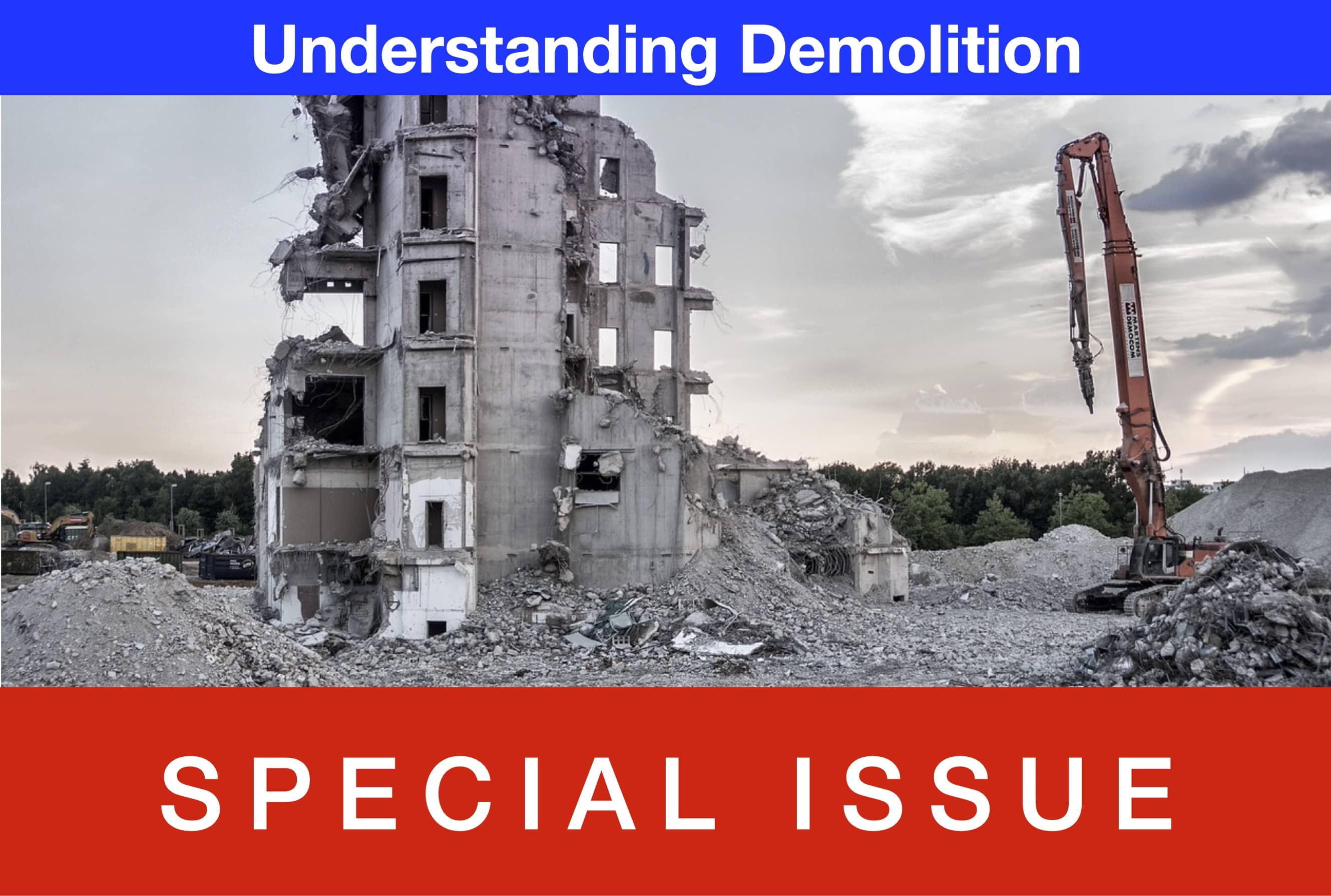
www.buildingsandcities.org/journal-content/special-issues/understanding-demolition2.html
Understanding Demolition

This special issue examines why demolition occurs, its consequences and how a more sustainable approach can be created.
In the sustainability discourse, the long-lasting nature of buildings and building stocks is rarely investigated. This special issue explores when, why and how demolition occurs with the aim to understand its environmental, socio-economic and cultural drivers, and consequences for policy and practice. The potential for avoiding building replacement (demolition and subsequent new build) and favouring retention is probed. Older buildings tend to be seen either as a problem and a threat, e.g. a contributor to climate change due to their allegedly excessive use of energy or, if they are heritage buildings, as being themselves threatened by the changing climate. New knowledge has emerged that challenges this perception, suggesting that older can potentially outperform new build. Profound questions arise about the nature of 'development' in the Global North. In particular, about public policies and whether the role and business models of the construction industry need to be reconfigured to a larger emphasis on stewardship of the existing building stock.
Guest editor: Satu Huuhka
This special issue frames demolition as a phenomenon. It is usually taken for granted or at most seen as a necessary evil; an inconvenient but inevitable part of the never-ending development of modern cities and societies. As a result, demolition has so far mainly been approached as a technical undertaking, a practical problem that mechanical engineering can help to solve effectively. There has been fairly little problematisation in- or outside of academia whether and how demolition helps to build environmentally, economically and socially sustainable cities, and when it is in fact helpful toward these goals.
The papers in the issue contribute insights from different scales, from the level of a building to that of a city. Eight case studies from various contexts, mainly Europe, but also the US and Australia, contribute novel methods, findings and policy insights.
The papers are categorised as: (1)
drivers and policies on demolition versus retention; (2) environmental and
social impact assessment on building level; and (3) practical demolition
decision-making. The contributions suggest, among other findings, positive
environmental impacts from building retention as opposed to demolition, and
discuss how policy designs from the city to the building level can either
encourage or discourage retention. Due to its implications, demolition and its alternatives should gain importance on
research, design, planning, construction and real estate agendas in the years
to come.
Table of contents
Understanding demolition [Editorial]
S. Huuhka
Policy tensions in demolition: Dutch social housing and circularity
P. Jonker-Hoffrén
Demolition or retention of existing buildings: drivers at the masterplan scale
H. Baker, A.
Moncaster, S. Wilkinson & H. Remøy
Demolition or adaptation?: post-industrial buildings in Ukraine
I. Serhiiuk
& I. Kalakoski
Renovate
or replace?: Consequential replacement LCA framework for buildings
S. Huuhka,
M. Moisio, E. Salmio, A. Köliö & J. Lahdensivu
GHG
emissions from building renovation versus new-build: incentives from assessment
methods
R.K. Zimmermann,
Z. Barjot, F.N. Rasmussen, T. Malmqvist, M. Kuittinen & H. Birgisdorttir
Social
life cycle assessment of adaptive reuse
R. Lundgren
Decision-making
analysis for Pittsburgh's deconstruction pilot using AHP and GIS
Z. Zhang
& J.D. Lee
Decision-support
for selecting demolition waste management strategies
M. van den
Berg, L. Hulsbeek & H. Voordijk
Feedback on the special issue
When is Demolition Justified?
Colin Rose
Time to Question Demolition!
André Thomsen
Latest Peer-Reviewed Journal Content
Designing for pro-environmental behaviour change: the aspiration–reality gap
J Simpson & J Uttley
Lifetimes of demolished buildings in US and European cities
J Berglund-Brown, I Dobie, J Hewitt, C De Wolf & J Ochsendorf
Expanding the framework of urban living labs using grassroots methods
T Ahmed, I Delsante & L Migliavacca
Youth engagement in urban living labs: tools, methods and pedagogies
N Charalambous, C Panayi, C Mady, T Augustinčić & D Berc
Co-creating urban transformation: a stakeholder analysis for Germany’s heat transition
P Heger, C Bieber, M Hendawy & A Shooshtari
Placemaking living lab: creating resilient social and spatial infrastructures
M Dodd, N Madabhushi & R Lees
Church pipe organs: historical tuning records as indoor environmental evidence
B Bingley, A Knight & Y Xing
A framework for 1.5°C-aligned GHG budgets in architecture
G Betti, I Spaar, D Bachmann, A Jerosch-Herold, E Kühner, R Yang, K Avhad & S Sinning
Net zero retrofit of the building stock [editorial]
D Godoy-Shimizu & P Steadman
Co-learning in living labs: nurturing civic agency and resilience
A Belfield
The importance of multi-roles and code-switching in living labs
H Noller & A Tarik
Researchers’ shifting roles in living labs for knowledge co-production
C-C Dobre & G Faldi
Increasing civic resilience in urban living labs: city authorities’ roles
E Alatalo, M Laine & M Kyrönviita
Co-curation as civic practice in community engagement
Z Li, M Sunikka-Blank, R Purohit & F Samuel
Preserving buildings: emission reductions from circular economy strategies in Austria
N Alaux, V Kulmer, J Vogel & A Passer
Urban living labs: relationality between institutions and local circularity
P Palo, M Adelfio, J Lundin & E Brandão
Living labs: epistemic modelling, temporariness and land value
J Clossick, T Khonsari & U Steven
Co-creating interventions to prevent mosquito-borne disease transmission in hospitals
O Sloan Wood, E Lupenza, D M Agnello, J B Knudsen, M Msellem, K L Schiøler & F Saleh
Circularity at the neighbourhood scale: co-creative living lab lessons
J Honsa, A Versele, T Van de Kerckhove & C Piccardo
Positive energy districts and energy communities: how living labs create value
E Malakhatka, O Shafqat, A Sandoff & L Thuvander
Built environment governance and professionalism: the end of laissez-faire (again)
S Foxell
Co-creating justice in housing energy transitions through energy living labs
D Ricci, C Leiwakabessy, S van Wieringen, P de Koning & T Konstantinou
HVAC characterisation of existing Canadian buildings for decarbonisation retrofit identification
J Adebisi & J J McArthur
Simulation and the building performance gap [editorial]
M Donn
Developing criteria for effective building-sector commitments in nationally determined contributions
P Graham, K McFarlane & M Taheri
Join Our Community

The most important part of any journal is our people – readers, authors, reviewers, editorial board members and editors. You are cordially invited to join our community by joining our mailing list. We send out occasional emails about the journal – calls for papers, special issues, events and more.
We will not share your email with third parties. Read more



Latest Commentaries
COP30 Report
Matti Kuittinen (Aalto University) reflects on his experience of attending the 2025 UN Conference of the Parties in Belém, Brazil. The roadmaps and commitments failed to deliver the objectives of the 2025 Paris Agreement. However, 2 countries - Japan and Senegal - announced they are creating roadmaps to decarbonise their buildings. An international group of government ministers put housing on the agenda - specifying the need for reduced carbon and energy use along with affordability, quality and climate resilience.
Building-Related Research: New Context, New Challenges
Raymond J. Cole (University of British Columbia) reflects on the key challenges raised in the 34 commissioned essays for Buildings & Cities 5th anniversary. Not only are key research issues identified, but the consequences of changing contexts for conducting research and tailoring its influence on society are highlighted as key areas of action.